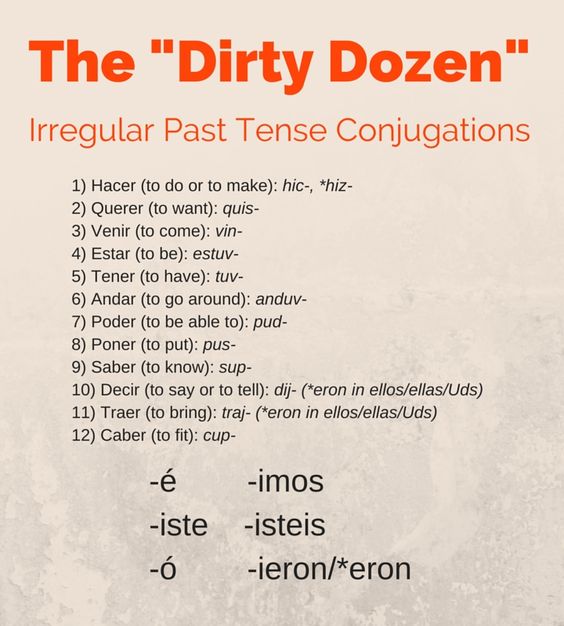
#Decir preterite endings how to#
In Spanish Preterite Tense, the 3 regular patterns are for verbs ending in ar, er, and ir. Learn how to conjugate decir in El Pretrito Indefinido in Spanish yo. A verb which does not follow these patterns exactly is called an irregular verb. Irregular VerbsĪ verb is called a regular verb when its conjugation follows a typical pattern. The imperfect tense is rarely irregular and can be easily conjugated from this form, which is the yo, and él/ella conjugation. The Spanish preterite is used to talk about beginnings and endings of events, often using the verbs comenzar (to begin), empezar (to start), terminar (to finish). Therefore, they use the irregular preterite endings, and also have irregular preterite stems. Other verbs with a similar pattern are traer and conducir. The present perfect tense is formed by combining the auxiliary verb haber with the participio. (You said everything I wanted to hear.) The Spanish verb decir has multiple conjugations that are used depending on the context. The verbs traer (to bring) and decir (to say, tell) are also both irregular in the preterite tense. In the preterite tense conjugations, the irregular endings of decir include the letter j, as in dije (I said). Traer appears on the 100 Most Used Spanish Preterite Tense Verbs Poster as the 23rd most used irregular verb.įor the present tense conjugation, go to Traer Conjugation - Present Tense. Traer is conjugated as an irregular verb in the preterite tense. Spanish Verb Conjugation: yo traje, t trajiste, l / Ud. Select desired playback speed.Traer is a Spanish verb meaning to bring. Preterite (Past Tense) Conjugation of traer Pretrito (pretrito perfecto simple) de traer. Video too fast or too slow? Change the playback speed of the video. Fill in the missing letters to form the correct preterite. Three of the irregular preterite tense verbs that youve learned so far - hacer, saber, and estar - use these endings. eron (NOT ieron) PRETERITE PART VI: PRACTICE A. o nosotros imos vosotros isteis ellos, ellas, Uds. We were so sorry you couldn't attend our reunion. They use the same endings as the other irregular stem verbs (see PRETERITE: PART V), with the exception of the ellos/ellas/Uds.

Dilogos Verbs that Require Special Accentuation Present. Boot Verbs Time Expressions Present Progressive El Juego del Pato Chapter 7- Lesson B. Sentímos que no pudiste asistir a nuestra reunión. La Casa Vocab La cocina y el comedor Decir Querer gustara and tener expressions Regular and boot verbs, pedir vs preguntar Chapter 7- Lesson A. I saw Luis but I was not able to speak with him. Decir appears on the 100 Most Used Spanish. Decir is conjugated as an irregular verb in the preterite tense.


Use these conjugations to refer to things people said at a specific moment in time. Decir is a stem-changing verb in the present tense, so in order to form the subjunctive, we need to take the present stem ' dig- ' and add the subjunctive endings. Decir is a Spanish verb meaning to say, to tell. As shown in the conjugation chart below, we must use the stem dij to form the preterite tense. Sentences using poder in the preterite tense The preterite conjugations of decir are all irregular. The preterite tense endings are: e, iste, o, imos, isteis, ieron yo It is a u-stem verb, the stem changes from o to u.

The verb poder (to be able) is irregular in the preterite tense.


 0 kommentar(er)
0 kommentar(er)
